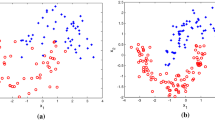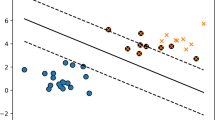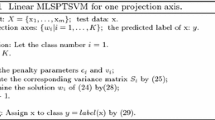Abstract
Traditionally, multi-plane support vector machines (SVM), including twin support vector machine (TWSVM) and least squares twin support vector machine (LSTSVM), consider all of points and view them as equally important points. In real cases, most of the samples of a dataset are highly correlated. These samples generally lie in the high-density regions and may be important for performances of classifiers. This motivates the rush toward new classifiers that can sufficiently take advantage of the points in the high-density regions. Illuminated by several new geometrically motivated algorithms, we propose density-based weighting multi-surface least squares classification (DWLSC) method, which is designed for classification. Considering the special features of multi-plane SVMs, DWLSC can measure the importance of points sharing the same labels by density weighting method and sufficiently make the full use of margin point information between pairs of points from different classes. It also includes naturally an extension of the non-linear case. In addition to keeping the respective advantages of both TWSVM and LSTSVM, our method improves the separation of the points sharing different classes and is shown to be better than other multi-plane classifiers in favor of reduction in space complexity, especially when confronted with the non-linear case. In addition, experimental evidence suggests that our method is effective in performing classification tasks.
Similar content being viewed by others
References
Argyriou A, Herbster M, Pontil M (2005) Combing graph Laplacians for semi-supervised learning. NIPS
Bradley S, Mangasarian OL (2000) Massive data discrimination via linear support vector machines. Optim Methods Softw 13: 1–10
Burges CJC (1998) A tutorial on support vector machines for pattern recognition. Data Min Knowl Discov 2(2): 121–167
Cover TM, Hart PE (1967) Nearest neighbor pattern classification. IEEE Trans Inf Theory 13: 21–27
Chung FRK (1997) Spectral graph theory. In: Regional conference series in mathematics, vol 92
Cai D, He X, Zhou K, Han J, Bao H (2007) Locality sensitive discriminant analysis. In: IJCAI, pp 708–713
Golub GH, Van Loan CF (1996) Matrix computations, 3rd edn. The John opkins University Press, Baltimore, MD
Fung G, Mangasarian OL (2001) Proximal support vector machine Classifiers. In: Provost F, Srikant R (eds) Proceedings KDD-2001: knowledge discovery and data mining, vol 2991, pp 77–86
Ghorai S, Mukherjee A, Dutta PK (2009) Nonparallel plane proximal classifier. Signal Process 89: 510–522
Jayadeva , Khemchandai R, Chandra S (2007) Twin support vector machines for pattern classification. IEEE Trans Pattern Anal Mach Intell TPAMI 29(5): 905–910
Jolliffe, IT (ed) (1986) Principal component analysis. Springer, New York, NY
Kumar AM, Gopal M (2009) Least squares twin support vector machines for pattern classification. Expert Syst Appl 36: 7535–7543
Lafon S, Keller Y, Coifman RR (2006) Data fusion and multicue data matching by diffusion Maps. IEEE Trans Pattern Anal Mach Intell PAMI 28(11): 1784–1797
Mangasarian O, Wild E (2006) Multisurface proximal support vector machine classification via generalized eigenvalues. IEEE Trans Pattern Anal Mach Intell 28(1): 69–74
Muphy PM, Aha DW (1992) UCI repository of machine learning databases
Mosek (2007). http://www.mathworks.com
Musicant DR (1998) NDC: normally distributed clustered datasets. http://www.cs.wisc.edu/~musicant/data/ndc
Mitchell, TM (ed) (1997) Machine learning. McGraw-Hill, Boston, MA
Matti P, Tomi N, Topi M, Markus T (2005) View-based recognition of real-world textures. Pattern Recognit 37(2): 313–323
Michael JP, Jane M, Greg G (2009) Learning terrain segmentation with classifier ensembles for autonomous robot navigation in unstructured environments. J Field Robot 26(2): 145–175
Tezel SK, Latecki LG (2010) Improving SVM classification on imbalanced time series data sets with ghost points. Knowl Inf Syst, 16 June 2010 (online firstTM)
Vapnik, VN (ed) (1995) The nature of statistical learning theory. Springer, New York, NY
Vapnik, V (ed) (1998) Statistical learning theory. Wiley, New York, NY
Yang XB, Chen SC, Chen B, Pan ZS (2009) Proximal support vector machine using local information. Neurocomputing 73(1–3): 357–365
Ye QL, Zhao CX, Ye N (2010) Multi-weight vector projection support vector machines. Pattern Recognit Lett 31(13): 2006–2011
Ye QL, Zhao CX, Ye N (2010) Least squares twin support vector machine classification via maximum one-class within class variance. Optim Methods Softw [first published on: 18 Aug 2010 (iFirst)]
Ye QL, Zhao CX, Ye N (2010) Localized twin SVM via convex minimization. Neurocomputing 74(4): 580–587
Author information
Authors and Affiliations
Corresponding author
Rights and permissions
About this article
Cite this article
Ye, Q., Ye, N. & Gao, S. Density-based weighting multi-surface least squares classification with its applications. Knowl Inf Syst 33, 289–308 (2012). https://doi.org/10.1007/s10115-012-0499-4
Received:
Revised:
Accepted:
Published:
Issue Date:
DOI: https://doi.org/10.1007/s10115-012-0499-4




